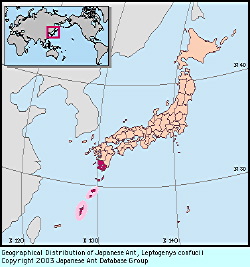
|
species
|
Leptogenys confucii
|
 |
Japanese Name
|
Hashiri-hari-ari
|
Original Reference
|
|
Forel, A. (1912) H Sauter's Formosa-Ausbeute: Formicidae. Entomologische Mitteilungen 1: 45-81.
|
Description
|
|
Total body length of workers around 4.5 mm. Body dark reddish brown to blackish brown; legs yellow. Head slender, anterior margin of clypeus triangular. Mandibles elongate, toothless. Eyes well developed, situated anteriorly on the head capsule. Mesosoma slender; pro- and mesonota slightly convex dorsally; metanotal groove distinctly incised dorsally. Petiole long, with convex dorsal outline in profile; narrow in dorsal view. Legs long, tarsal claws pectinate (a feature unique in ants to Leptogenys).
|
Remarks
|
|
Nests are found under stones or rotting wood, or in forest leaf-litter. They include only a few tens of workers. When nests are breached the workers disperse rapidly, so it is difficult to census colonies. Reproductive females are ergatoid. Males are winged and typically ponerine in habitus, but with pectinate tarsal claws.
|
|

Distribution
|
|
Kyushu (Cape Sata, Kagoshima Pref.), Nansei Is; Taiwan.
|
|
References
|
|
- H. Sauter's Formosa-Ausbeute: Formicidae. Entomologische Mitteilungen 1: 45-81.
|
Editor
|
|
Original text by Mamoru Terayama and Masao Kubota. English tranlation by M. Terayama, edited by Robert W. Taylor.
|
|